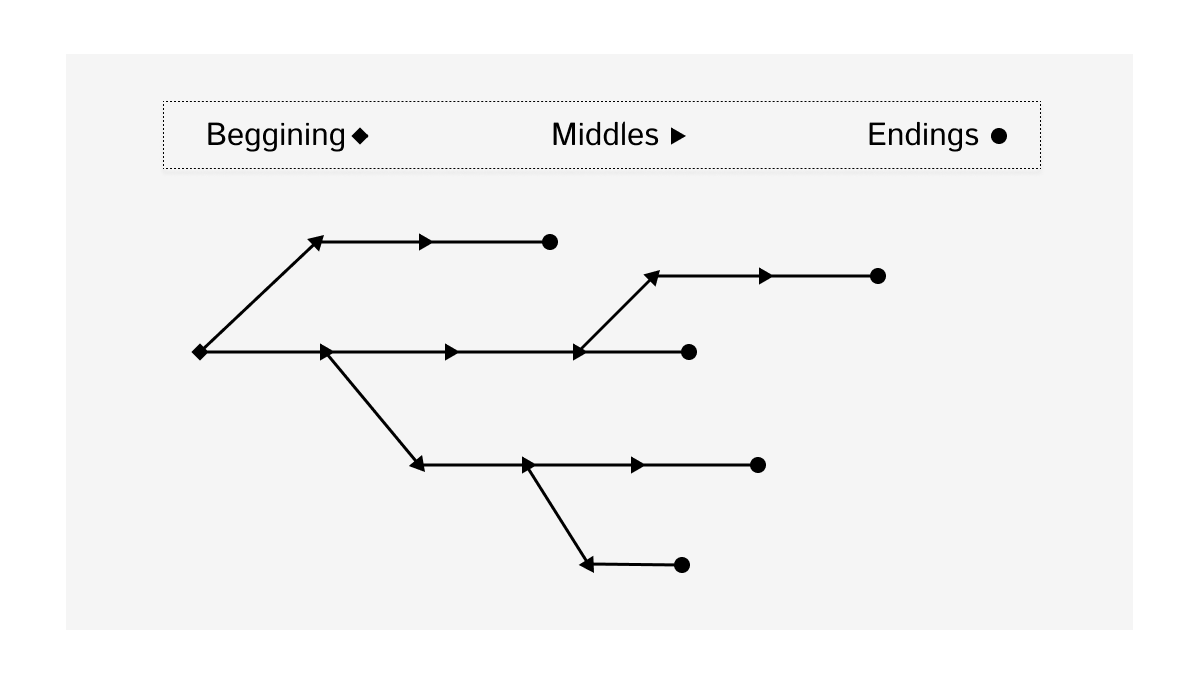The Power Of Storytelling For Virtual Training
In general, employees interact with training content out of obligation. Whether it’s to earn a bonus or avoid reprimands in their quarterly performance evaluation, organizational learning is driven by extrinsic motivations. In other words, external factors like winning a prize or avoiding punishment. The best designers of virtual training are aware of this reality. That’s why they seek strategies to awaken intrinsic motivation. For example, they create experiences that make employees feel capable and give them personal satisfaction, such as teaching them to do a task they couldn’t do before, or sparking a genuine interest in the content. That’s why they turn to the art of storytelling.
As human beings, we have a natural interest in stories. To begin with, we love unraveling mysteries, and a story is precisely a mystery with three parts: a beginning, a middle, and an end. As we listen to what happens, we simultaneously imagine the possible outcomes. The inherent need to make predictions about what will happen keeps the listener engaged in the story, and in the case of virtual training, it maintains the active interest of the worker in the training.
Second, stories evoke familiarity, which is crucial for learning something new. The environment of a story uses cultural references, such as customs, expressions, and gestures. This already familiar information helps create connections with the new information. As a result, memorizing and understanding new concepts becomes easier. In training, the familiarity of a story set in the work context aids in the retention of new information and its application.
Third, stories evoke emotions, which, in turn, help new ideas leave a profound imprint in our minds. This type of retention is vital for learning. Hence, a story can genuinely motivate an employee who feels obligated to engage in corporate training.
Isn’t it incredible? As a designer of training experiences, you surely find it fascinating. The challenge arises when you have to choose which strategy to use, whether it’s linear storytelling or interactive storytelling.
The Basics Of Linear And Interactive Storytelling You Need To Know
Whether you’re a designer passionate about experimenting with various tools, or your boss asks you to use interactive storytelling in the company’s training one day, remember that in adult learning, each strategy shines in specific problems. First, remember that both include the basic elements of any story. This involves characters in a specific setting who want to achieve something. After overcoming one or more obstacles, they learn something about themselves.
To decide when strategy works better than the other, start by identifying the type of training challenge you are facing. Then, familiarize yourself with the strengths and limitations of each strategy. Finally, inform and educate the decision-makers in your team about them. This way, the efforts to design learning experiences will focus on addressing employees’ learning gaps, rather than including a strategy just because it seems innovative.
When To Use Linear Storytelling
Telling a story linearly means that it progresses in chronological order, that is, in the order in which events occur. In this order, there is a beginning that introduces the characters, their daily lives, and what they seek; a middle that reveals the obstacles preventing them from obtaining what they want; and a single ending that showcases the overcoming of obstacles and the acquired learning. Examples of cultural narratives using linear storytelling include movies like the ones in the Jurassic Park franchise, Toy Story (1995), or a novel like The Road by Cormac McCarthy (2006).
In the case of learning, a teacher might use the story of Romeo and Juliet to teach students about the theme of love. In corporate training, linear storytelling is used with a case and narration-based approach, as shown in this sample of an eLearning. The linear approach works well for learning challenges where:
- The information to be conveyed for employee use is explicit. In other words, correct answers, procedures, specific steps, and rules can be clearly identified.
- Employees need to follow specific steps and rules to avoid undesirable or dangerous situations and make informed decisions in the workplace.
- The chronological order allows employees to easily process the information.
- Also, the narrative structure helps them focus on the desired and undesired consequences. As a result, the story serves as a model for employees to learn what to do or not to do in a given situation.
Furthermore, one of the main advantages of linear storytelling is related to the production timelines of training programs that include it. Since constant access to Subject Matter Experts (SMEs) is not necessary to define the story, as it has only one ending, few resources are required. Therefore, they are quicker to produce and ideal when there is a tight timeframe between production and implementation.
On the other hand, when it comes to limitations, linear storytelling falls short for certain training challenges. Imagine that at a call center, you need to train an agent on how to empathize with itinerant users. Also, suppose that for a software company, you need to train your salespeople to identify verbal and gestural signals of when to offer a premium product.
In the first case, how do you expose the agent to the different reactions a real-life user could have? How do you prepare them to handle various user emotions? Do you think a story told linearly is sufficient? Now, consider the second case. How do you teach the salesperson about the multiple signals that can appear in a conversation with a potential buyer? A linear story seems limited because many nuances will be left out. So, when training gaps involve processes where a single correct answer cannot be defined, and there are several gray areas when making decisions and taking action, interactive storytelling is the best option.
What You Should Know About Interactive Storytelling
Telling a story interactively means that the learner can intervene in the story’s evolution. This narrative takes the chronology of a tale to another level because, after the beginning, the middle unfolds with multiple options or narrative branches, leading to various endings. In popular culture, one of the most well-known examples is “Bandersnatch”, an episode of the Netflix series Black Mirror [1]. In this interactive experience, users can choose different story paths based on the options they select.
In the world of virtual training, projects that include interactive storytelling usually have a scenario-based approach. Here is a witty and creative example by Ryan Martin, called “Broken Co-worker.”
These stories work so well because interactive storytelling is the best for training challenges involving complex emotional contexts. The primary criterion for choosing this approach is that you need the learner to experience the consequences of their decisions to learn and practice skills that take longer to acquire. Here are other moments when opting for this strategy to design virtual training truly helps employees:
- Interaction with the story and its characters serves as a resource to make mistakes, recover from failure, and keep trying.
- The user needs the experience to act and see the consequences of their decisions in a safe space.
Julie Dirksen, in her book Design for How People Learn [2], defines emotional context as one of the most challenging aspects when designing for learning. She gives an example where a person takes a course on the principles of giving feedback, and then, when the time comes to deliver it, even though they have the information, they don’t know how to use it with someone in a bad mood and irritable. As she explains it, the person may know what to do and say, but they do nothing they were taught in the training when experiencing the situation, because they weren’t trained to handle the emotionally stressful context. Such gaps are an opportunity for interactive storytelling to shine.
Its benefits are related to the emotional context that can be recreated in virtual training. Since the user can influence the story’s outcomes, it generates a unique sense of power to act and intervene. As a result, the emotional connection with the training becomes more complex because it is closer to what they experience in reality.
This complexity includes feeling sympathy by being interested in the emotions of the story’s characters with whom they identify. And also, empathy by experiencing the consequences of their decisions each time they choose a specific narrative path and reach a particular ending. Such ability to act within the story positively impacts the worker’s interest in the training, awakening genuine motivation (provided that the quality of the content, assessment, and other design elements are also high).
In the case of the limitations with this strategy, unlike linear storytelling, the interactive strategy requires longer production times. So it is a viable option if there is a flexible and ample window between production times and the launch and implementation date. Although this may be considered a flaw, it should also be analyzed under the savings promoted by using this training to replace in-person activities, which often involve higher costs.
Takeaways
So, what training gap do you have at hand, and which type of storytelling is suitable for you? Remember these essentials:
- Storytelling in virtual training is a powerful tool for engaging learners and sparking intrinsic motivation.
- Stories evoke familiarity, making it easier to connect new information with existing knowledge and enhancing memorization and comprehension.
- Linear storytelling is effective when conveying explicit information, specific steps, and rules in training scenarios where chronological order aids in understanding; while interactive storytelling is beneficial for training challenges involving complex situations, multiple options, and personalized interactions, allowing learners to make choices and experience the consequences of their decisions.
- Emotional context plays a crucial role in effective learning, and interactive storytelling can recreate emotional experiences, allowing learners to practice skills in emotionally stressful situations.
- When choosing between linear and interactive storytelling, it is important to consider the specific training challenge, the strengths and limitations of each approach, and to inform decision-makers about the factors influencing the choice.
References:
[1] Watch Netflix’s explanation of how it works. [2] Dirksen, Julie. 2016. Design for How People Learn. 2nd Edition. Sebastopol, CA.: New Riders.Image Credits:
- The images within the body of the article were created/supplied by the author.


